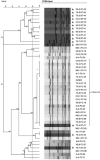Wide but Variable Distribution of a Hypervirulent Campylobacter jejuni Clone in Beef and Dairy Cattle in the United States
- PMID: 28970227
- PMCID: PMC5717212
- DOI: 10.1128/AEM.01425-17
Wide but Variable Distribution of a Hypervirulent Campylobacter jejuni Clone in Beef and Dairy Cattle in the United States
Abstract
Campylobacter jejuni clone SA is the major cause of sheep abortion and contributes significantly to foodborne illnesses in the United States. Clone SA is hypervirulent because of its distinct ability to produce systemic infection and its predominant role in clinical sheep abortion. Despite the importance of clone SA, little is known about its distribution and epidemiological features in cattle. Here we describe a prospective study on C. jejuni clone SA prevalence in 35 feedlots in 5 different states in the United States and a retrospective analysis of clone SA in C. jejuni isolates collected by National Animal Health Monitoring System (NAHMS) dairy studies in 2002, 2007, and 2014. In feedlot cattle feces, the overall prevalence of Campylobacter organisms was 72.2%, 82.1% of which were C. jejuni Clone SA accounted for 5.8% of the total C. jejuni isolates, but its prevalence varied by feedlot and state. Interestingly, starlings on the feedlots harbored C. jejuni in feces, including clone SA, suggesting that these birds may play a role in the transmission of Campylobacter In dairy cattle, the overall prevalence of clone SA was 7.2%, but a significant decrease in the prevalence was observed from 2002 to 2014. Whole-genome sequence analysis of the dairy clone SA isolates revealed that it was genetically stable over the years and most of the isolates carried the tetracycline resistance gene tet(O) in the chromosome. These findings indicate that clone SA is widely distributed in both beef and dairy cattle and provide new insights into the molecular epidemiology of clone SA in ruminants.IMPORTANCEC. jejuni clone SA is a major cause of small-ruminant abortion and an emerging threat to food safety because of its association with foodborne outbreaks. Cattle appear to serve as a major reservoir for this pathogenic organism, but there is a major gap in our knowledge about the epidemiology of clone SA in beef and dairy cattle. By taking advantage of surveillance studies conducted on a national scale, we found a wide but variable distribution of clone SA in feedlot cattle and dairy cows in the United States. Additionally, the work revealed important genomic features of clone SA isolates from cattle. These findings provide critically needed information for the development of preharvest interventions to control the transmission of this zoonotic pathogen. Control of C. jejuni clone SA will benefit both animal health and public health, as it is a zoonotic pathogen causing disease in both ruminants and humans.
Keywords: Campylobacter jejuni; cattle; clone SA; prevalence.
Copyright © 2017 Tang et al.
Figures


Similar articles
-
Molecular evidence for zoonotic transmission of an emergent, highly pathogenic Campylobacter jejuni clone in the United States.J Clin Microbiol. 2012 Mar;50(3):680-7. doi: 10.1128/JCM.06167-11. Epub 2011 Dec 21. J Clin Microbiol. 2012. PMID: 22189122 Free PMC article.
-
Molecular epidemiology and public health relevance of Campylobacter isolated from dairy cattle and European starlings in Ohio, USA.Foodborne Pathog Dis. 2013 Mar;10(3):229-36. doi: 10.1089/fpd.2012.1293. Epub 2012 Dec 21. Foodborne Pathog Dis. 2013. PMID: 23259503
-
Genetic diversity and antimicrobial susceptibility of Campylobacter jejuni isolates associated with sheep abortion in the United States and Great Britain.J Clin Microbiol. 2014 Jun;52(6):1853-61. doi: 10.1128/JCM.00355-14. Epub 2014 Mar 19. J Clin Microbiol. 2014. PMID: 24648552 Free PMC article.
-
Campylobacter-Associated Diseases in Animals.Annu Rev Anim Biosci. 2017 Feb 8;5:21-42. doi: 10.1146/annurev-animal-022516-022826. Epub 2016 Nov 9. Annu Rev Anim Biosci. 2017. PMID: 27860495 Review.
-
The Prevalence of Campylobacter in Live Cattle, Turkey, Chicken, and Swine in the United States and Canada: A Systematic Review and Meta-Analysis.Foodborne Pathog Dis. 2021 Apr;18(4):230-242. doi: 10.1089/fpd.2020.2834. Epub 2020 Dec 7. Foodborne Pathog Dis. 2021. PMID: 33290141
Cited by
-
Zoonotic Transmission of Campylobacter jejuni to Caretakers From Sick Pen Calves Carrying a Mixed Population of Strains With and Without Guillain Barré Syndrome-Associated Lipooligosaccharide Loci.Front Microbiol. 2022 Apr 29;13:800269. doi: 10.3389/fmicb.2022.800269. eCollection 2022. Front Microbiol. 2022. PMID: 35591997 Free PMC article.
-
Molecular detection and genetic characterization of Arcobacter butzleri isolated from red-footed pet tortoises suspected for Campylobacter spp. from Grenada, West Indies.PLoS One. 2020 Mar 16;15(3):e0230390. doi: 10.1371/journal.pone.0230390. eCollection 2020. PLoS One. 2020. PMID: 32176736 Free PMC article.
-
Whole genome characterization of thermophilic Campylobacter species isolated from dairy manure in small specialty crop farms of Northeast Ohio.Front Microbiol. 2023 Mar 21;14:1074548. doi: 10.3389/fmicb.2023.1074548. eCollection 2023. Front Microbiol. 2023. PMID: 37025625 Free PMC article.
-
Stress Response and Virulence Potential Modulating Effect of Peppermint Essential Oil in Campylobacter jejuni.Biomed Res Int. 2019 Jan 3;2019:2971741. doi: 10.1155/2019/2971741. eCollection 2019. Biomed Res Int. 2019. PMID: 30719441 Free PMC article.
-
The Role of European Starlings (Sturnus vulgaris) in the Dissemination of Multidrug-Resistant Escherichia coli among Concentrated Animal Feeding Operations.Sci Rep. 2020 May 15;10(1):8093. doi: 10.1038/s41598-020-64544-w. Sci Rep. 2020. PMID: 32415136 Free PMC article.
References
-
- Chowdhury MN. 1984. Campylobacter jejuni enteritis; a review. Trop Geogr Med 36:215–222. - PubMed
-
- CDC. 2016. Infection with pathogens transmitted commonly through food and the effect of increasing use of culture-independent diagnostic tests on surveillance—Foodborne Diseases Active Surveillance Network, 10 U.S. sites, 2012–2015. MMWR Morb Mortal Wkly Rep 65:368–371. - PubMed
Publication types
MeSH terms
LinkOut - more resources
Full Text Sources
Other Literature Sources
Medical
Miscellaneous

